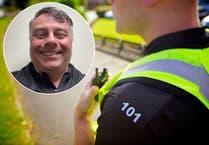MOST older readers will be well aware that for its size Teignmouth was probably the most heavily bombed town in the country.
To commemorate the 50th anniversary of the start of the war, a local daily newspaper produced a 64-page special headlined Our War and detailing the raids in south Devon.
Not surprisingly Teignmouth was heavily featured after 228 houses were demolished and 79 citizens killed and 15l wounded.
The statistics and photos of the carnage were all contained in the 1989 publication, and a three-page spread headlined Teignmouth’s Terror described in great detail the carnage.
The text read: ‘It is in fact hardly an exaggeration to say that nearly every one of its dwellings, of which there are about 3000, suffered to some degree.
‘It also had the mortification of seeing its hospital Mill Lane hospital which was not fully completed until as late as 1939 utterly wiped out.
‘In the 21 raids, 70 high explosives and 1,000 incendiaries spreadeagled the town, and wide areas were devastated, a particularly heavy toll being taken of working class homes.
‘The earliest bombs that came down fell, fortunately, in the sea, and it was on the evening of March 2, 1941, that the enemy first left a real mark – five high explosives being dropped on the Mill Lane area, causing death and destruction in the avenues.
‘Just over two months later the hospital was destroyed, killing 10 patients and nurses. Five bombs fell on the adjoining Kingsway estate.
Seven days later came another visitation, but this time the bombs fell in the sea.
‘Alerts, of which there have been 460 continued at frequent intervals until October 24 when two bombs fell on the Exeter Road district between Yannon Drive, Mount Everest Lodge and the Grammar School playing field.
‘There followed a lull until the middle of 1942 when three bombs killed killed four and injured 18 people living in the Bitton Street and Gloucester Road district. Before the month was out eight more were killed and 13 injured, principally in Bitton Avenue, in a daylight raid.
‘These were the days of the tip and run raider, and in August eight bombs killed 14 people and injured 23. The town hall received a direct hit, and Myrtle Hill, Parson Street, Albion Place, Barnpark Terrace and Higher Brimley also suffered.
One of the bombs fell at Shaldon and exploded above the Torquay Road. A few weeks later more death and destruction followed when bombs fell in Higher Brook Street. Two hotels on the seafront, the Esplanade and the Berkeley, were also shattered.
One of the bombs fell close to the junior school, but happily the children were in the building.
A few minutes later it would have been 4pm and they would have been prey to flying debris and dust in the streets.
Park Street, a congested and and poor residential area, also suffered, along with Reed Vale where a private school and nursing home were situated. Luckily the scholars were away on half term holiday.
‘Fire, which probably came from the machine gunning and cannon firing which usually accompanied nearly all the raids, caused fire in the roof of St James Church.
Other areas targeted were Powderham Terrace, Alexandra Terrace, Salisbury Terrace, Saxe Street, and Chapel Street, where some bodies remained buried for days, Bitton Park and the offices of the urban council.
‘In all agony and death and destruction, the spirit and Teignmouth’s people was never beaten and no praise is too high for their stoicism, or performance of its Civil Defence and and utility service personnel who rescued trapped victims, succored casualties and the homeless, restored services and made damage good.
Rest centre workers also played their part,and on one occasion they had about 300 homeless in their care.
Recognition came in the form of awards by King George V1 to two of the town’s workers - the BEM to Mr J S Scown, leader of the rescue parties, and the MBE to Brig-Gen J Morrison, the honorary ARP officer.
The town now looks hopefully to the future, visualising a brighter and better Teignmouth that will take its rightful place among the seaside resorts of Britain.
The task of preparing a plan of reconstruction has been placed in the hands of the eminent architect Prof S. D. Adshead, whose proposals are eagerly awaited.
Other south Devon towns also suffered, including Newton Abbot, where two German bombers and a fighter attacked the railway station on August 20, 1940. In those days it was a considerable railway junction with engine sheds and workshops playing a major role in GWR operations.
Four GWR employees and 10 members of the public lost their lives in the attack, which badly damaged a platform and two locos,2785 and Aylburton Grange 6801. Railway cottages close to the bridge were also badly damaged.





Comments
This article has no comments yet. Be the first to leave a comment.